Issue: 64 Page: 44-51
The Secret Garden: Important Chinese Herbs in American Horticulture: A Photo Essay
by Steven Foster
HerbalGram. 2004; 64:44-51 American Botanical Council
The Secret Garden: Important Chinese Herbs in American Horticulture: A Photo Essay
In 1976, a walk through Harvard Yard with Arnold Arboretum botanist (emerita),
Shu Ying Hu, PhD, alerted me to the possibility that Chinese medicinal plants
were found in American horticulture, most known as ornamentals, with their medicinal
use a secret to those who grew them. That experience has stretched to more than
a quarter century interest in documenting Chinese herbs in American gardens. A
result of that interest is my 1992 book co-authored with Professor Yue Chongxi,
Herbal Emissaries: Bringing Chinese Herbs to the West.1
Since that time, interest in growing Chinese medicinal plants either as herbal
specimen plants, herbal horticultural collectibles, sources of plant material
for clinical practice, or commercial cultivation has continued to expand. The
first effort to develop a garden of Chinese medicinal herbs was in the early 1980s
at the University of California Botanical Garden, at U.C. Berkeley, in cooperation
with the American College of Traditional Chinese Medicine, San Francisco, and
the Guangzhou College of Traditional Chinese Medicine in Guangzhou, China. Seed
of Chinese medicinal plants then became available through various institutional
seed exchange programs. Eventually, seed reached those interested in horticultural
development of these plants. Among the growers was Elixir Farm Botanicals, LLC
in Brixey, Missouri, which in the early 1990s began selling seeds of ornamental
garden plants that also doubled as Chinese medicinal herbs. Recently, Elixir donated
its retail seed business to a non-profit, the Ozark Botanical Garden, Inc., which
operates an online seed store at www.one-garden.org.
The one-garden Web site not only features the Elixir Chinese herb collection,
but also an additional 1,000 species formerly known as the “deep diversity collection,”
donated to the organization by Seeds of Change in Santa Fe, New Mexico. In recent
years, plants of rare and unusual Chinese medicinal herbs have also been made
available by Plantit Herbs in Athens, Ohio (www.plantitherbs.com).
Plantit Herbs’ offerings include all of the species listed below and over 130
additional species of Chinese herbs. In 2003, the Northeast Organic Farmers Association,
New York, co-sponsored a project on “New York Grown Chinese Medicinal Herbs” with
High Falls Gardens, in Columbia County, New York. The project includes five certified
organic farms growing production trials of Chinese wolfberry (Lycium chinense
Mill., Solanaceae), Chinese cucumber (Trichosanthes kirilowii Maxim., Cucurbitaceae),
bitter melon (Momordica charantia L., Cucurbitaceae), and schisandra (Schisandra
chinensis [Trucz.] Baill., Schisandraceae).2
Quietly behind the scenes of these and other efforts to grow Chinese herbs
for traditional Chinese medicine (TCM) practitioners in the U.S. was Los Angeles
acupuncturist, Robert Newman. As a student at the American College of Traditional
Chinese Medicine in San Francisco in the early 1990s, Newman began a living collection
of Chinese medicinal plants, which swelled to a specimen garden of over 1,000
species in containers kept in the College parking lot. He spent the next four
years on the staff of the College carefully tending the collection with little
or no institutional support, and then decided to go to China for additional training.
At this point he dispersed his collection to Jean Giblette at High Falls Gardens,
Vinnie McKinney at Elixir Farms, and Cindy Riviere at Plantit Herbs, among others.
Newman then left for China, which led to service as Curator of the Medicinal Plant
Gardens at Nanjing Botanical Garden for nearly two years before returning to Los
Angeles. Through the efforts of these and other individuals and organizations,
medicinal plants that are part of the everyday pharmacopeia of TCM have become
widely available through the above sources, and well-known national purveyors
of herbs seeds and plants. In this photo essay, we hope to introduce some common
Chinese medicinal herbs that until the last decade have been rare specimens in
American horticulture.

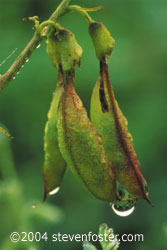 Astragalus
membranaceus (Fisch. ex Link) Bunge, commonly known as astragalus
in the herb trade or huangqi (root) as a traditional Chinese herbal drug,
is a member of the pea family (Fabaceae), indigenous to northeast Asia. The genus
Astragalus is one of the largest genera of flowering plants with over 1,750
species.3 Huangqi was listed in the superior class of herbs
in the 2000-year-old classic, the Divine Plowman’s materia medica, Shen Nong
Ben Cao Jing (1st century CE). Huang means “yellow,” referring
to the yellow interior of the root, while qi means “leader,” in reference
to the fact that this is one of the superior tonic roots in Traditional Chinese
Medicine. In the Medical Casebook of Shi Shan (Shi Shan Yi An),
published in 1531, two supplements are included discussing huangqi and
its use with ginseng (Panax ginseng C.A. Meyer, Araliaceae), still well-known
as a tonic for fatigue and general debility. Astragalus existed only as a rare
specimen plant in American horticulture for many decades. The plant was introduced
to the United States through the Plant Introduction Office of the United States
Department of Agriculture (USDA) in 1925. It came from the Botanical Garden in
Leningrad (now St. Petersburg), and it was introduced primarily for the research
needs of forage-crop specialists. Germplasm is still maintained through the National
Germplasm System of USDA. In recent years, other accessions have come to the U.S.
from Korea, Japan, as well as Chinese botanical gardens, through seed exchange
programs in which botanical gardens worldwide participate. Seed and plants are
now distributed through specialty seeds companies and nurseries, and the plant
is relatively common in herb gardens specializing in medicinal plants. Small-scale
commercial cultivation has been in place in North America for more than a decade.
In China the roots are harvested when plants are four to five years old. Before
completely dry, the roots are generally sliced into thin diagonal slices, or sliced
lengthwise, producing a dried product that looks much like a tongue depressor,
a form commonly seen in American herb markets. Primary consumer use is to improve
immune system functions. In TCM astragalus is used to invigorate vital energy
qi (or ch’i) and strengthen bodily defenses, promote tissue regeneration
(e.g., healing skin sores), promote diuresis (e.g., for edema due to cardiac insufficiency),
and disperse poisons (e.g., reduce swellings due to pathogens), among other uses.1,
4 Astragalus
membranaceus (Fisch. ex Link) Bunge, commonly known as astragalus
in the herb trade or huangqi (root) as a traditional Chinese herbal drug,
is a member of the pea family (Fabaceae), indigenous to northeast Asia. The genus
Astragalus is one of the largest genera of flowering plants with over 1,750
species.3 Huangqi was listed in the superior class of herbs
in the 2000-year-old classic, the Divine Plowman’s materia medica, Shen Nong
Ben Cao Jing (1st century CE). Huang means “yellow,” referring
to the yellow interior of the root, while qi means “leader,” in reference
to the fact that this is one of the superior tonic roots in Traditional Chinese
Medicine. In the Medical Casebook of Shi Shan (Shi Shan Yi An),
published in 1531, two supplements are included discussing huangqi and
its use with ginseng (Panax ginseng C.A. Meyer, Araliaceae), still well-known
as a tonic for fatigue and general debility. Astragalus existed only as a rare
specimen plant in American horticulture for many decades. The plant was introduced
to the United States through the Plant Introduction Office of the United States
Department of Agriculture (USDA) in 1925. It came from the Botanical Garden in
Leningrad (now St. Petersburg), and it was introduced primarily for the research
needs of forage-crop specialists. Germplasm is still maintained through the National
Germplasm System of USDA. In recent years, other accessions have come to the U.S.
from Korea, Japan, as well as Chinese botanical gardens, through seed exchange
programs in which botanical gardens worldwide participate. Seed and plants are
now distributed through specialty seeds companies and nurseries, and the plant
is relatively common in herb gardens specializing in medicinal plants. Small-scale
commercial cultivation has been in place in North America for more than a decade.
In China the roots are harvested when plants are four to five years old. Before
completely dry, the roots are generally sliced into thin diagonal slices, or sliced
lengthwise, producing a dried product that looks much like a tongue depressor,
a form commonly seen in American herb markets. Primary consumer use is to improve
immune system functions. In TCM astragalus is used to invigorate vital energy
qi (or ch’i) and strengthen bodily defenses, promote tissue regeneration
(e.g., healing skin sores), promote diuresis (e.g., for edema due to cardiac insufficiency),
and disperse poisons (e.g., reduce swellings due to pathogens), among other uses.1,
4
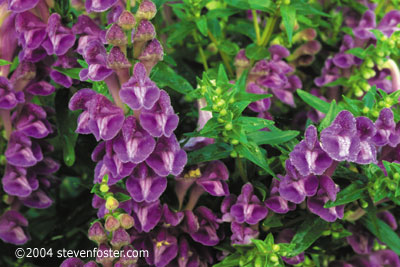
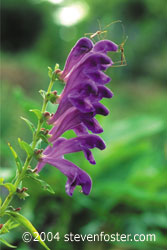 Scutellaria
baicalensis Georgi root is the traditional Chinese herb Huang-qin.
Also known as Baikal skullcap, this member of the mint family (Lamiaceae) is a
perennial found in sandy mountain soils in northeast China and adjacent Russia,
Korea, Mongolia, Japan, and the mountains of southwest China, north of the Yangtze
River.5 It is probably the most widely used of the 98 species of Scutellaria
that occur in China. It was first described in Western terms by a German-born
botanist Johann Gottlieb Georgi (1729–1802), a professor of the Russian Academy
of Sciences in St. Petersburg. Based on collections from far eastern Russia, Georgi
provided the first botanical description of the plant in a 1775 publication describing
the flowering plants of the Lake Baikal region. Subsequently, European botanists
in China collected the plant in the late nineteenth century. Soon thereafter,
the plant became known as a rare specimen in European botanical gardens, sometimes
under the synonyms S. macrantha Fisch. or S. lanceolaria Miquel.
The plant was featured in Curtis’s Botanical Magazine in 1848 in issue
75, plate 4420; that suggests it was established in English horticulture by the
mid 1800s. In the following year several botanical and horticultural publications
in Belgium also featured the plant.6 Exactly when the plant arrived
in the United States is obscure. In the United States it is sometimes grown in
botanical gardens, but more often, can be found in the collections of rock gardeners,
who grow it for its showy blue flowers and its adaptability to extreme cold and
dry conditions. Its first mention in Chinese materia medica (herbals) comes in
Shen Nong Ben Cao Jing in the middle class of drugs. Today, the root is
widely used in traditional Chinese medicine to treat febrile conditions (i.e.,
infections causing fever), to counteract toxicity (e.g., symptoms of viral infections),
and to stop bleeding (e.g., in cases where there is “heat in the blood” causing
the blood to overflow the vessels, as occurs in some infectious diseases). It
is the most well studied Scutellaria species chemically and pharmacologically.1,
4 Scutellaria
baicalensis Georgi root is the traditional Chinese herb Huang-qin.
Also known as Baikal skullcap, this member of the mint family (Lamiaceae) is a
perennial found in sandy mountain soils in northeast China and adjacent Russia,
Korea, Mongolia, Japan, and the mountains of southwest China, north of the Yangtze
River.5 It is probably the most widely used of the 98 species of Scutellaria
that occur in China. It was first described in Western terms by a German-born
botanist Johann Gottlieb Georgi (1729–1802), a professor of the Russian Academy
of Sciences in St. Petersburg. Based on collections from far eastern Russia, Georgi
provided the first botanical description of the plant in a 1775 publication describing
the flowering plants of the Lake Baikal region. Subsequently, European botanists
in China collected the plant in the late nineteenth century. Soon thereafter,
the plant became known as a rare specimen in European botanical gardens, sometimes
under the synonyms S. macrantha Fisch. or S. lanceolaria Miquel.
The plant was featured in Curtis’s Botanical Magazine in 1848 in issue
75, plate 4420; that suggests it was established in English horticulture by the
mid 1800s. In the following year several botanical and horticultural publications
in Belgium also featured the plant.6 Exactly when the plant arrived
in the United States is obscure. In the United States it is sometimes grown in
botanical gardens, but more often, can be found in the collections of rock gardeners,
who grow it for its showy blue flowers and its adaptability to extreme cold and
dry conditions. Its first mention in Chinese materia medica (herbals) comes in
Shen Nong Ben Cao Jing in the middle class of drugs. Today, the root is
widely used in traditional Chinese medicine to treat febrile conditions (i.e.,
infections causing fever), to counteract toxicity (e.g., symptoms of viral infections),
and to stop bleeding (e.g., in cases where there is “heat in the blood” causing
the blood to overflow the vessels, as occurs in some infectious diseases). It
is the most well studied Scutellaria species chemically and pharmacologically.1,
4

 Codonopsis
pilosula (Franch.) Nannf. and Codonopsis tangshen Oliv. are
members of the Campanulaceae (bellflower) family, which serve among the source
plants for dang shen root. The plant has also been called “bastard ginseng,”
since the root has been perceived as a low-priced ginseng substitute in TCM (it
is not related to true Asian ginseng, Panax ginseng). In the horticultural
trade, the plant group is known as bonnet bellflowers. The genus Codonopsis
includes 30 or more species of herbaceous perennials native to Central and East
Asia, and as far south as Malaysia.3, 7 About half of these species
have been used as official or local source plants of the traditional Chinese medicine
dang shen. At least 20 species of Codonopsis are found in American
gardens, primarily in the gardens of those who collect the rare and unusual, and
in rock gardens. These showy, but delicate, perennials first reached European
gardens in the early nineteenth century and arrived in the United States during
the last half of the century.7 Codonopsis means bell-like. Interestingly,
ancient Chinese herbalists did not seem to know dang shen. It first appears
in Ben Cao Cong Xin, by Wu Yi-luo, published in 1751 during the Qing dynasty.
It is also described in Zhao Xue-min’s, 1765 Qing dynasty classic, Ben Cao
Gang Mu Shi Yi (Omissions from the Grand Materia Medica). Today, dang
shen is used in prescriptions to reinforce qi and invigorate the function
of the spleen (e.g., promote digestion and absorption of nutrients, increase qi)
and lung systems (e.g., aid in recovery from lung ailments), as understood in
a TCM context.1, 4 Codonopsis
pilosula (Franch.) Nannf. and Codonopsis tangshen Oliv. are
members of the Campanulaceae (bellflower) family, which serve among the source
plants for dang shen root. The plant has also been called “bastard ginseng,”
since the root has been perceived as a low-priced ginseng substitute in TCM (it
is not related to true Asian ginseng, Panax ginseng). In the horticultural
trade, the plant group is known as bonnet bellflowers. The genus Codonopsis
includes 30 or more species of herbaceous perennials native to Central and East
Asia, and as far south as Malaysia.3, 7 About half of these species
have been used as official or local source plants of the traditional Chinese medicine
dang shen. At least 20 species of Codonopsis are found in American
gardens, primarily in the gardens of those who collect the rare and unusual, and
in rock gardens. These showy, but delicate, perennials first reached European
gardens in the early nineteenth century and arrived in the United States during
the last half of the century.7 Codonopsis means bell-like. Interestingly,
ancient Chinese herbalists did not seem to know dang shen. It first appears
in Ben Cao Cong Xin, by Wu Yi-luo, published in 1751 during the Qing dynasty.
It is also described in Zhao Xue-min’s, 1765 Qing dynasty classic, Ben Cao
Gang Mu Shi Yi (Omissions from the Grand Materia Medica). Today, dang
shen is used in prescriptions to reinforce qi and invigorate the function
of the spleen (e.g., promote digestion and absorption of nutrients, increase qi)
and lung systems (e.g., aid in recovery from lung ailments), as understood in
a TCM context.1, 4
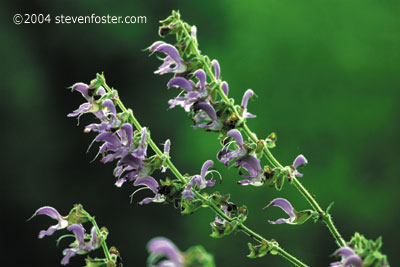
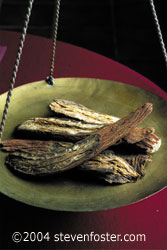 Salvia
miltiorrhiza Bunge, Chinese salvia, Chinese sage, or redroot sage,
is a member of the mint family (Lamiaceae), whose root is the source of the Chinese
traditional drug dan shen (not to be confused with dang shen, above).
The Russian botanist Alexander von Bunge (1803–1890) gave the plant its Latin
name in an 1833 publication. The French Jesuit, D’Incarville, introduced seed
of the plant from Beijing to Paris in the late eighteenth century, where it was
cultivated as a rare botanical specimen.8 Collectors of Chinese medicinal
plants in the United States primarily grow the plant as a specimen. This is a
very commonly used Chinese herbal medicine, first mentioned in the primary or
upper class of medicinal plants in Shen Nong Ben Cao Jing. The root is
primarily used in prescription to promote blood flow and relieve pain, such as
in menstrual disorders, also arthritis, and angina pectoris. During the past century,
it has become a very commonly used traditional Chinese herb.1,4 Salvia
miltiorrhiza Bunge, Chinese salvia, Chinese sage, or redroot sage,
is a member of the mint family (Lamiaceae), whose root is the source of the Chinese
traditional drug dan shen (not to be confused with dang shen, above).
The Russian botanist Alexander von Bunge (1803–1890) gave the plant its Latin
name in an 1833 publication. The French Jesuit, D’Incarville, introduced seed
of the plant from Beijing to Paris in the late eighteenth century, where it was
cultivated as a rare botanical specimen.8 Collectors of Chinese medicinal
plants in the United States primarily grow the plant as a specimen. This is a
very commonly used Chinese herbal medicine, first mentioned in the primary or
upper class of medicinal plants in Shen Nong Ben Cao Jing. The root is
primarily used in prescription to promote blood flow and relieve pain, such as
in menstrual disorders, also arthritis, and angina pectoris. During the past century,
it has become a very commonly used traditional Chinese herb.1,4

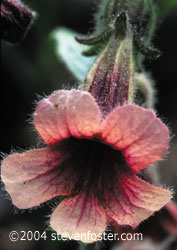 Rehmannia
glutinosa Libosch. ex Fisch. & Mey. is a member of the figwort
family (Scrophulariaceae). Once classified as a species of Digitalis (D.
glutinosa Gaertn., Scrophulariaceae), the genus of nine species is sometimes
placed in the Gesneriaceae (gesneriad) family. Another species, known as Chinese
foxglove (R. elata N.E. Br.) has been cultivated as an ornamental flower.3
According to Professor Yue Chongxi (emeritus) Institute of Chinese Materia Medica,
Academy of Traditional Chinese Medicine in Beijing, the plant has many cultivated
varieties and is produced in many parts of China. Yue compares di-huang
roots to apples in terms of the variations in flavor.1 Some are sweet;
some are sour; others have a banana-like taste. The size of the root and plant
are extremely variable based on local environmental conditions. The many varieties
and forms of Rehmannia, however, are believed to belong to a single species.
Three separately prepared products from the root are used as di-huang.
Gan-di-huang (sheng-di-huang) or dried Rehmannia root consists
of freshly harvested roots, baked slowly until nearly dry, then kneaded into round
balls. Xian-di-huang or fresh di-huang consists of the crude, newly
harvested, and cleaned roots. Shu-di-huang or prepared Rehmannia
root is a dried root that has been steamed to a black color and then re-dried.
Di-huang is first mentioned in Shen Nong Ben Cao Jing. In ancient times,
smaller forms of the plant were utilized. In recent centuries, the plant has become
somewhat larger in habit through selection of improved varieties, though it is
the same species that was used by the ancient Chinese. Different preparations
for the roots are indicated for different functions in TCM. The unprocessed root,
for example, is used to reduce heat in the blood (e.g., to stop bleeding), promote
production of body fluid (e.g., to overcome dryness of mucous membranes), and
nourish yin (e.g., to calm the yang and replenish fluids). The fresh root is used
in febrile conditions with impaired yin. The processed root is used to nourish
yin and tonify the blood.1,4 Rehmannia
glutinosa Libosch. ex Fisch. & Mey. is a member of the figwort
family (Scrophulariaceae). Once classified as a species of Digitalis (D.
glutinosa Gaertn., Scrophulariaceae), the genus of nine species is sometimes
placed in the Gesneriaceae (gesneriad) family. Another species, known as Chinese
foxglove (R. elata N.E. Br.) has been cultivated as an ornamental flower.3
According to Professor Yue Chongxi (emeritus) Institute of Chinese Materia Medica,
Academy of Traditional Chinese Medicine in Beijing, the plant has many cultivated
varieties and is produced in many parts of China. Yue compares di-huang
roots to apples in terms of the variations in flavor.1 Some are sweet;
some are sour; others have a banana-like taste. The size of the root and plant
are extremely variable based on local environmental conditions. The many varieties
and forms of Rehmannia, however, are believed to belong to a single species.
Three separately prepared products from the root are used as di-huang.
Gan-di-huang (sheng-di-huang) or dried Rehmannia root consists
of freshly harvested roots, baked slowly until nearly dry, then kneaded into round
balls. Xian-di-huang or fresh di-huang consists of the crude, newly
harvested, and cleaned roots. Shu-di-huang or prepared Rehmannia
root is a dried root that has been steamed to a black color and then re-dried.
Di-huang is first mentioned in Shen Nong Ben Cao Jing. In ancient times,
smaller forms of the plant were utilized. In recent centuries, the plant has become
somewhat larger in habit through selection of improved varieties, though it is
the same species that was used by the ancient Chinese. Different preparations
for the roots are indicated for different functions in TCM. The unprocessed root,
for example, is used to reduce heat in the blood (e.g., to stop bleeding), promote
production of body fluid (e.g., to overcome dryness of mucous membranes), and
nourish yin (e.g., to calm the yang and replenish fluids). The fresh root is used
in febrile conditions with impaired yin. The processed root is used to nourish
yin and tonify the blood.1,4
References:
1. Foster
S, Yue CX. Herbal Emissaries: Bringing Chinese Herbs to the West. Rochester, VT: Healing Arts Press; 1992.
2. Craker
LE, Giblette J. Chinese medicinal herbs: Opportunities for domestic production.
p. 491–496. In: Janick J, Whipkey A (eds.), Trends in new crops and new uses. Alexandria, Virginia: ASHS Press; 2002.
3. Mabberly
DJ. The Plant-Book. 2nd. ed. Cambridge:
Cambridge University Press; 1997.
4. Yao
DM, Zhang JB. A Coloured Atlas of the Chinese Materia Medica Specified in
Pharmacopoeia of the People’s Republic of China (1995 Edition). Guangdong: Guangdong Science & Technology
Press; 1996.
5. Wu
ZY, Raven PH, eds. Flora of China Verbenaceae
through Solanaceae. Vol. 17. Beijing:
Science Press, St. Louis: Missouri Botanical Garden; 1997.
6. Merrill
ED, Walker EH. A Bibliography of Eastern Asiatic Botany. Jamaica Plain, Massachusetts: The Arnold Arboretum
of Harvard University; 1938.
7. Bailey LH. The Garden of Bellflowers in North America. New York:
Macmillan; 1953.
8. Bretschneider
E. History of European Botanical Discoveries in China. 2 vols. (reprint 1981) Leipzig: Zentral-Antiquariat
der Deutschen Demokratischen Republik; 1898.
Steven Foster began his career 30 years ago at the Herb Department
of the Sabbathday Lake, Maine, Shaker Community. He is the author of over 700
popular articles and is well known for his photography. Steven is also the author
of 14 books, including three Peterson Field Guides. He lives in the Ozarks. Foster
serves as the president of the Steven
Foster Group, Inc., providing consulting, editorial; and stock photography
services.
|